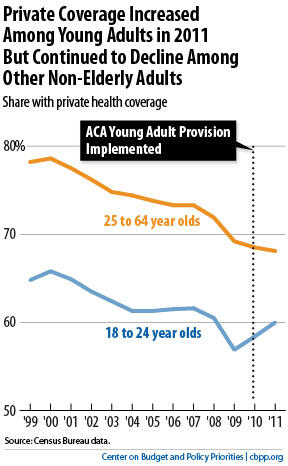BEYOND THE NUMBERS
Health Reform and Other Federal Policies Cut Number of Uninsured in 2011, Census Data Show
The number of uninsured Americans fell for the first time in four years, and the share of Americans without health insurance experienced the largest single-year drop since 1999, the Census Bureau announced yesterday. The data suggest that health reform and other federal policies are a significant part of the reason.
The new Census figures show that:
- The overall number of uninsured Americans fell in 2011 by 1.3 million, to 48.6 million.
- The share of Americans without insurance coverage fell from 16.3 percent in 2010 to 15.7 percent in 2011.
- Some 2.3 million more low-income individuals were enrolled in Medicaid and the Children’s Health Insurance Program (CHIP) in 2011 than in 2010, helping to reduce the number without health insurance.
We take a closer look at the Census findings in a paper released today.
A substantial rise in health coverage among young adults — which mainly reflected a health reform provision enabling adult children to get coverage through their parents’ health insurance plans until their 26th birthday — accounted for much of the drop in the uninsured.
The year 2011 was the first full year that the young adult provision affected health insurance coverage rates. To assess its impact, consider that while the rate of private coverage rose by 1.6 percentage points among the young adults that the rule targets, it fell by 0.4 percentage points among all non-elderly adults aged 25 to 64 (see graph). The increase in private coverage among young adults allowed the overall percentage of people with private coverage to remain steady, at 63.9 percent, for the first time in 10 years.

The overall gains in coverage also reflected a rise in the number and percentage of Americans with public health insurance — principally through Medicare, Medicaid, and CHIP. More people enrolled in these programs as the population aged and employer-based coverage continued to erode among those aged 25 to 64.
The progress in 2011 partially reversed the losses in coverage during the last several years, when the uninsured rate rose from 14.7 percent in 2007 to 16.3 percent in 2010 and the number of uninsured people climbed from 44.1 million to 50.0 million. Coverage levels remain below those before the Great Recession of 2007 to 2009, however, with 4.5 million more Americans uninsured in 2011 than in 2007.
The ranks of the uninsured should fall substantially starting in 2014, when health reform’s major coverage provisions will begin to be implemented. Some 30 million people who would otherwise be uninsured will gain coverage by 2022, the Congressional Budget Office estimates — and that number could grow larger if all or nearly all states adopt health reform’s Medicaid expansion.
Click here for our full analysis.
